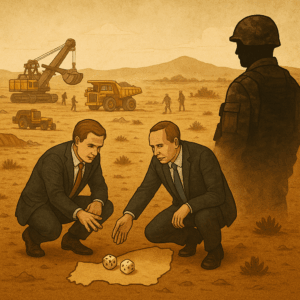Could it be that the Viola MacMillan Award foreshadows misfortune for its recipients?
The correlation is too strong — and eerie to ignore.
March 2024. John McConnell of Victoria Gold stepped onto stage to receive the award for the financing of the Eagle Gold Mine. Four and a half months later, a leach pad failure precipitated a crisis which spiraled into an unexpected and rapid end for his company.
March 2021. Mark O’Dea of Pure Gold Mining was the recipient. A few months later his Madsen gold project entered commercial production. But from the beginning, the mine’s production was erratic, failing to meet expectations. One and a half years after receiving the award, his company was bankrupt.
March 2019. Guy Bourassa ascended the stage to accept the award on behalf of Nemaska Lithium. Nine months earlier, he had pulled off a CDN $1.1 billion-dollar financing to build the Whabouchi mine. Six months after the award, a cost overrun halted construction. A few months later, Nemaska declared bankruptcy.
In each of these failures, hundreds of millions of shareholder equity were wiped out. Debt holders suffered significant losses. Their net worth and reputation took a big hit.
In examples one and three, the speed with which their crowning achievements disintegrated after the award was eerily unsettling. No doubt they experienced baptism by fire.
As extreme as their situation was, they were not alone.
Looking back to when the award was first introduced in 1985, many recipients have experienced a decline in their fortunes, reputation, or a combination of both.
Examples: two long-time partners credited with a big gold discovery in Ontario broke up; a billion-dollar (capex) diamond mine went bankrupt; an underperforming gold mine in Nunavut; a fantastic low-grade mine in Quebec snatched from its owner by two majors in a hostile takeover; a tragic ending for a bankrupt NWT gold mine that still leaves a toxic environmental legacy decades later; after two consecutive homeruns, a promoter met his Waterloo in Colorado. And so on.
As for corporate recipients, they seemed to fare much better than their individual counterparts.
THE CURSE OF THE COVER
Is it possible that the award’s individual recipients fell victim to the curse-of-the-cover phenomenon? Of course, they didn’t appear on any magazine cover, but the substance of the recognition is the same.
No one stays at the top forever. So when someone appears on the cover of a major magazine like Time or receives a distinguished award, it’s often a sign they have reached the peak of their career.
The descent downward to equilibrium, more often than not, is unavoidable. It could be rapid, gradual, or anywhere in between, depending on a number of factors, including their personality, temperament and character.
Everyone’s situation is different.
In American football, for about twenty years now, promising NFL players featured on the cover of the Madden NFL games would suffer a terrible accident that would sideline them or force them to never play football again.
A surprising number of people who appeared on the cover of Forbes magazine – Elizabeth Holmes, Sam Bankman-Fried, two of the most infamous examples – have ended up in jail.
When a company appears on the cover of Fortune magazine, it’s a signal for some traders to be contrarian and short the company’s stock.
THE SILVER LINING OF FAILURE
At first glance, failure is terrible. Everyone dreads it, doing their best to avoid it. Despite one’s best intentions and efforts, missteps are inevitable.
Could the disaster, setback, or blunder that haunts them have been part of their life plan they set for themselves before birth? What purpose do such trials and tribulations serve?
After all, the world is a stage, and we are here to learn and experience a variety of conditions and contrasts —success and failure; poverty and riches; love and hate, joy and sorrow, and more.
(In my book, Into the Unknown, a thriller about a geologist held hostage by Islamic fundamentalists in the remote reaches of Mali, the deeper meaning of such adversities and ordeals is discussed at length by one of the characters.)
For all you know, the collapse of their beloved companies could have been a blessing in disguise for them.
Let me explain.
A mine is a dynamic complex system, despite the stereotyped image of it being as mostly an earth-moving operation. An operation mining rare earths, graphite, or lithium is even more challenging as the chemical processes involved in making the final products are vastly more complicated.
(Having studied chemical engineering, I have a deep appreciation for the complexity involved in such an operation.)
For a mine to work as intended, a multifaceted blend of variables – mining rates, chemical processing, geology, metallurgy, workflow, and management knowhow, to name just a few – need to mesh together.
More often than not, there’s a flaw somewhere in the operation. It could be conceptual (open-pit versus underground mining); inadequate geological understanding; operational issues leading to lower-than-expected recovery rates, to name just a few. If not corrected, the flaw will eventually doom the enterprise.
The reality is that it’s impossible to control all the risks inherent in a mine that, by definition, is a complex system in and by itself. If something can go wrong, then it will. And if a company doesn’t have a reserve of capital and (technical) talents, an unexpected shock can put it out of business.
It’s possible that behind the scenes, the stress of managing a complex system may have been slowly killing them, destroying their marriage, or ruining their health.
Only they truly know. We, as observers, do not. But Spirit knows. Their higher self knows. For their highest good, Spirit says, “O frazzled child, time to restore balance in your life. Time to shed the old identity. Time to learn a new lesson. Time to embark on a new journey.”
And then the transformation begins.
While the in the thick of the greatest challenge of their life, they may not appreciate it. But five to ten years after the traumatic event, with the benefit of hindsight and perspective, they may even openly admit it has enriched their lives and transformed them into more authentic and likable individuals.
(Hai is the author of Into the Unknown, an international thriller about a geologist taken hostage by Islamic fundamentalists in Mali.)









